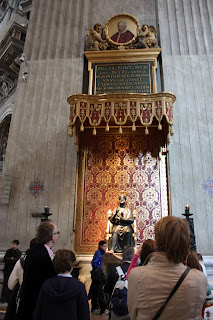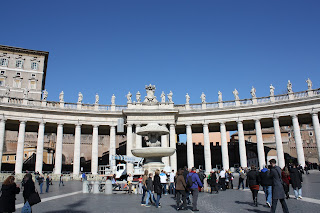Since yesterday was Ash Wednesday, a group of us decided that we would try and find a small church where we could attend mass for the evening. Luckily, mass was just starting at the church right by studio after our class just ended! Mass in Italian is very interesting to say the least, especially since I'm not Catholic and I had no idea what was going on most of the time. When it was time to go and get our ashes all of the people in the congregation formed a single line and waited for the priest to distribute them. I was very confused when I saw people coming back without crosses on their forehead. Then, it came to be my turn to receive the ashes and instead of being marked with a cross, he just sprinkled ashes in my hair. I just thought maybe this was a Catholic thing until all of my other friends were very confused by this too. Anyway, this was how we experienced and Italian Ash Wednesday. For a little, tiny church in the Jewish ghetto, I think this is one of my favorites!
To keep going in the Catholic spirit, today (23 Feb.) for history class we visited St. Peter's Basilica in the Vatican! This is one of the most impressive buildings I have ever seen. The axial approach from the street alone is amazing!
 |
| Approach of St. Peter's Basilica |
The obelisk that sits out front was moved to be lined up exactly in front of the church. This was partly done to symbolize Christianity's triumph over Paganism. It sits centered in the piazza which was designed by Bernini. The design is an oval shape which represents an opening and embracing of the visitors to the space.
 |
Obelisk in the Piazza
in front of St. Peter's |
Here you can see the dome just peeking over the top of the church. The dome was one of the last things added since it was so large and difficult to construct. The new St. Peter's was under construction for many, many years and went through many changes of popes and architects. As a result, the building remained unfinished and started to be called the "ruins" of St. Peter's.
 |
| St. Peter's Basilica |
At one point, no construction happened for five years, temporary protective roofs had to be put on but they too deteriorated rapidly and there were even plants that were starting to grow in the nave which really did make this comparable to some of the ancient ruins. The original plan was done by Bramante but the later and current plan was done by Michelangelo which was added onto by Maderno, however, many aspects of the current church still look back to Bramante's ideas.
 |
| Central Nave |
La Pieta is a sculpture done by Michelangelo which depicts Mary holding Jesus after his death on the cross. He completed this in 1498-1499 when he was only 23 years old. This is also the only piece that Michelangelo ever signed because people were associating this sculpture with someone else. He also signed it Michelangelo Buonarroti, Florentine whic
h shows how proud he was to have been from Florence at a time when the different regions of Italy were not united.
 |
| La Pieta, by Michelangelo |
The dome above the chapel that holds
La Pieta is also very exquisitely decorated with many, many paintings.
 |
| Dome above the Chapel of La Pieta |
This is the interior of the Holy Door which is only opened every 25 years on the Jubilee year. When the Jubilee year is over, the entrance is plastered shut and is not broken through again until the next Jubilee comes.
 |
| Holy Door Interior |
 |
| Holy Door Exterior |
This is the chapel where Pope John Paul II was laid to rest after the papacy had declared him a saint. This is where he will remain. Many visitors crowd around to try and get a peak at the tomb.
 |
| Chapel of St. John Paul II |
The way the church is decorated is just amazing, especially when the sun comes streaming through.
 |
| Ceiling in Central Nave |
Touching the foot of the bronze statue of St. Peter is a tradition done by many pilgrims paying homage.
 |
| Bronze statue of St. Peter |
The
Baldacchino by Bernini is a bronze piece which sits directly over the tomb of St. Peter.
 |
| Baldacchino, by Bernini |
It too is very lavishly decorated and the spiral columns are referencing the Temple of Solomon.
 |
| Upper detail of the Baldacchino |
The massive, massive dome that sits atop the crossing of the nave and the transept is one of the most magnificent aspects of this church. The lettering on the bottom of the dome is actually 12' high even though it doesn't seem like it's that tall. By knowing how tall the letters actually are, you can somewhat get a sense of how massive this dome actually is.
 |
| Massive Dome |
This is an area where mass was going on at the time we visited. Instead of in front of the front altar, it was in one of the side transepts. There is also a daily mass at 5 which actually is in front of the main altar.
 |
| Left Transept |
The main altar shows Peter's throne encased in bronze as it is being carried up into heaven. The gilded rays of sun seem to be spilling out of the architectural elements and are actually pieces of stucco plaster that have been gilded. The stained glass window in the center represents the sun and ascending into heaven.
 |
Altar with St. Peter's throne encased
in bronze-also by Bernini |
The
Tomb of Alexander VII was also another sculpture by Bernini who was a favorite of many of the popes throughout the years. As a result, most of the sculptures in the church are done by either him or his workshop. This sculpture is particularly interesting because Bernini had to work around the existing door that is still used today which leads to the offices of the church. The marble appears to be cloth which is draped over the base partly covering the door. This is also one of the only depictions of a skeleton during this time. The gilded skeleton appears to be fighting through the cloth to get to Alexander and represents death and the fact that our life on earth is not forever.
 |
| Tomb of Alexander VII, by Bernini |
This is a view of the facade which was made of white travertine which gets very dirty and needs to be cleaned periodically. Here you can see many Greek influences such as the composite capitals and the pediment but some elements such as the balustrade were elements that weren't included until the Renaissance period.
 |
| Pediment and columns |
On the pavement of the piazza, there is a small disk where if you stand there, the quadruple colonnade lines up and it seems as though you are only viewing one row of columns. This is some of the illusion that was achieved during the Baroque period.
 |
| Central vanishing point |
St. Peter's is one of the buildings which tests the tectonic structure of the building as well as provide numerous points of illusion which makes this a very intriguing space. I can't wait to come back here for Easter Sunday mass-which I have tickets for! :)
P.S. I would just like to say that this is the first time that I have actually gotten the blog posted on the same day that I visited the site. Thank you, I know you all are impressed. :)



















No comments:
Post a Comment